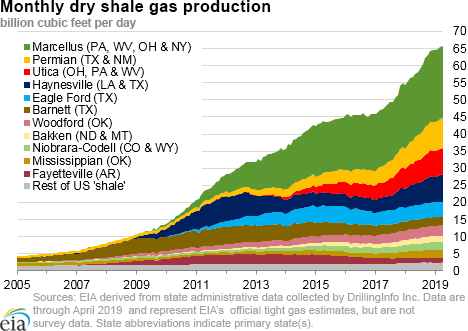In the News:
U.S. LNG exports to Europe increase amid declining demand and spot LNG prices in Asia
U.S. exports of liquefied natural gas (LNG) to Europe have increased substantially since October 2018, averaging 1.9 billion cubic feet per day (Bcf/d) in the winter of 2018–19 compared with 0.1 Bcf/d in the winter of 2017–18. U.S. LNG exports to Europe increased primarily as a result of tepid LNG demand in Asia because of warm winter, declining price differentials between European and Asian spot natural gas prices, and additional U.S. LNG supply that came online in the fourth quarter of 2018, increasing available global spot LNG supply. In March and April 2019, U.S. LNG exports to Europe averaged 1.7 Bcf/d, ten times higher than in the same months of last year, and accounted for more than one-third of all U.S. LNG exports in those months. Most of the U.S. LNG exports to Europe were sent from the Sabine Pass terminal in Louisiana.
Europe’s LNG imports in the winter months of 2018–19 averaged 10.2 Bcf/d, 60% higher than in the previous two winters and the highest winter average since at least 2013, according to CEDIGAZ LNG data. Russia, Nigeria and the United States were the three largest LNG suppliers to Europe from January through April 2019 (based on a four-month average), according to CEDIGAZ data. LNG imports have increased primarily in northwest Europe (Belgium, the Netherlands, and the United Kingdom) and southern Europe (France and Italy) during this period. LNG imports in Europe have been relatively low in recent years, but are expected to grow as new LNG supply comes online and European countries continue to increase natural gas consumption as part of their decarbonization initiatives.
LNG imports in the three largest global LNG markets (Japan, China, and South Korea), all located in northern Asia, remained high from November 2018 through January 2019, but started to decrease in February 2019 and remained low in subsequent months, consistent with seasonal consumption patterns. China, which has become world’s second largest LNG importer in 2017 overtaking South Korea, and also the world’s largest importer of natural gas in 2018 overtaking Japan, continued to increase LNG imports in the winter 2018-19. China LNG imports averaged 9.1 Bcf/d from December 2018 through February 2019, 20% higher than in the winter of 2018–19. During the same period, LNG imports in Japan and South Korea have declined by 10% and 5%, respectively, in part because of milder winter weather and nuclear restarts in Japan.
Declining price differentials between National Balancing Point (NBP) in the United Kingdom and Japan LNG spot prices affected the flow of flexible (i.e. without a fixed destination) U.S. LNG exports, which follow global spot natural gas price benchmarks. Because the transportation costs from the U.S. Gulf Coast to Europe are about $1.50 per million British thermal units (MMBtu) lower than those to Asian markets (for a round trip), a sufficiently narrow differential will make U.S. LNG exports to Europe more economical. The price differentials between Japan spot LNG and NBP prices were less than $1.00/MMBtu in December 2018 and January 2019 and reached a low of $0.60/MMBtu in April, which supported continued high U.S. LNG exports to Europe.
Overview:
(For the week ending Wednesday,June 5, 2019)
- Natural gas spot prices fell at most locations this report week (Wednesday, May 29, to Wednesday, June 5). Henry Hub spot prices fell from $2.63 per million British thermal units (MMBtu) last Wednesday to $2.39/MMBtu yesterday.
- At the New York Mercantile Exchange (Nymex), the June 2019 contract expired last Wednesday at $2.633/MMBtu. The July 2019 contract decreased to $2.378/MMBtu, down 25¢/MMBtu from last Wednesday to yesterday. The price of the 12-month strip averaging July 2019 through June 2020 futures contracts declined 16¢/MMBtu to $2.552/MMBtu.
- Net injections to working gas totaled 119 billion cubic feet (Bcf) for the week ending May 31. Working natural gas stocks are 1,986 Bcf, which is 10% more than the year-ago level and 11% lower than the five-year (2014–18) average for this week.
- The natural gas plant liquids composite price at Mont Belvieu, Texas, fell by 54¢/MMBtu, averaging $4.81/MMBtu for the week ending June 5. The price of butane, natural gasoline, isobutane, propane, and ethane all fell, by 14%, 12%, 11%, 9%, and 8%, respectively.
- According to Baker Hughes, for the week ending Tuesday, May 28, the natural gas rig count decreased by 2 to 184. The number of oil-directed rigs rose by 3 to 800. The total rig count increased by 1, and it now stands at 984.
Prices/Supply/Demand:
Prices fall at most locations across the country. This report week (Wednesday, May 29, to Wednesday, June 5), Henry Hub spot prices fell 24¢ from $2.63/MMBtu last Wednesday to a low of $2.39/MMBtu yesterday. Temperatures were close to normal across much of the Lower 48 states, with warmer-than-normal temperatures in the Pacific Northwest and cooler-than-normal temperatures in the Southwest and Northeast. At the Chicago Citygate, prices decreased 22¢ from a high of $2.43/MMBtu last Wednesday to $2.21/MMBtu yesterday.
California prices mixed. Prices at PG&E Citygate in Northern California fell 45¢, down from a high of $3.26/MMBtu last Wednesday to $2.81/MMBtu yesterday. Prices at SoCal Citygate increased 55¢ from $2.50/MMBtu last Wednesday to a high of $3.05/MMBtu yesterday amid cooler-than-normal temperatures and continued pipeline constraints. SoCalGas has delayed returning line L235-2, which delivers natural gas into SoCalGas’s Northern Zone, to service by a month; repairs are now estimated to end by July 5.
Northeastern prices fall. At the Algonquin Citygate, which serves Boston-area consumers, prices went down 2¢ from a high of $2.32/MMBtu last Wednesday to $2.30/MMBtu yesterday. At the Transcontinental Pipeline Zone 6 trading point for New York City, prices decreased 9¢ from a high of $2.33/MMBtu last Wednesday to $2.24/MMBtu yesterday.
Tennessee Zone 4 Marcellus spot prices decreased 17¢ from a high of $2.19/MMBtu last Wednesday to $2.02/MMBtu yesterday. Prices at Dominion South in southwest Pennsylvania fell 13¢ from $2.21/MMBtu last Wednesday to $2.08/MMBtu yesterday.
Permian Basin prices increase as pipeline work concludes. Prices at the Waha Hub in West Texas, which is located near Permian Basin production activities, averaged a low of -$0.80/MMBtu last Wednesday, $3.43/MMBtu lower than Henry Hub prices. Yesterday, prices at the Waha Hub averaged a high of $0.86/MMBtu, $1.53/MMBtu lower than Henry Hub prices. Prices returned to positive territory as the force majeure on the El Paso Natural Gas pipeline, which decreased takeaway capacity out of the Permian Basin, was lifted.
Supply is flat. According to data from PointLogic Energy, the average total supply of natural gas remained the same as in the previous report week, averaging 94.2 Bcf/d. Dry natural gas production decreased by 1% compared with the previous report week. Average net imports from Canada increased by 8% from last week.
Increased natural gas-fired power generation drives rising demand. Total U.S. consumption of natural gas rose by 4% compared with the previous report week, according to data from PointLogic Energy. Natural gas consumed for power generation climbed by 10% week over week. Industrial sector consumption increased by 2% week over week. In the residential and commercial sectors, consumption declined by 11%. Natural gas exports to Mexico increased by 1%.
U.S. LNG exports decrease week over week. Eight LNG vessels (six from Sabine Pass, one from Cove Point, and one from Cameron) with a combined LNG-carrying capacity of 33.4 Bcf departed the United States from May 30 to June 5, according to shipping data compiled by Bloomberg. One vessel was loading at the Sabine Pass terminal on Wednesday.
Cheniere Energy—the developer of the Sabine Pass and Corpus Christi liquefaction terminals in Louisiana and Texas—announced on Monday that the company made a Final Investment Decision to proceed with the development of Sabine Pass Train 6. Currently, Sabine Pass has five trains in operation, with a combined baseload LNG-production capacity of 2.96 Bcf/d (3.45 Bcf/d peak capacity). Train 6 has a full set of regulatory approvals and will have a 0.59 Bcf/d baseload LNG-production capacity.
Storage:
Net injections into storage totaled 119 Bcf for the week ending May 31, compared with the five-year (2014–18) average net injections of 102 Bcf and last year's net injections of 93 Bcf during the same week. Working gas stocks totaled 1,986 Bcf, which is 240 Bcf lower than the five-year average and 182 Bcf more than last year at this time.
According to The Desk survey of natural gas analysts, estimates of the weekly net change from working natural gas stocks ranged from net injections of 105 Bcf to 130 Bcf, with a median estimate of 110 Bcf.
The average rate of net injections into storage is 44% higher than the five-year average so far in the refill season (April through October). If the rate of injections into storage matched the five-year average of 9.6 Bcf/d for the remainder of the refill season, total inventories would be 3,452 Bcf on October 31, which is 240 Bcf lower than the five-year average of 3,692 Bcf for that time of year.
More storage data and analysis can be found on the Natural Gas Storage Dashboard and the Weekly Natural Gas Storage Report.
See also:
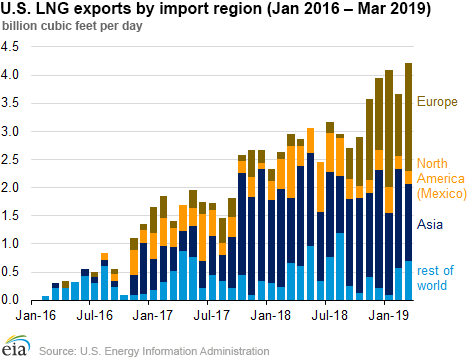
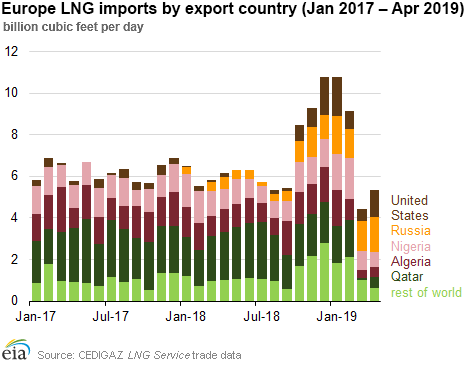
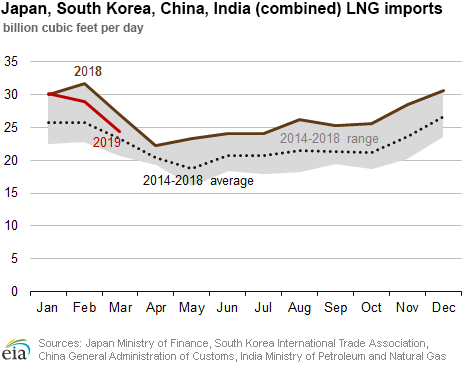 Japan Ministry of Finance, South Korea International Trade Association, India Ministry of Petroleum and Natural Gas
Japan Ministry of Finance, South Korea International Trade Association, India Ministry of Petroleum and Natural Gas
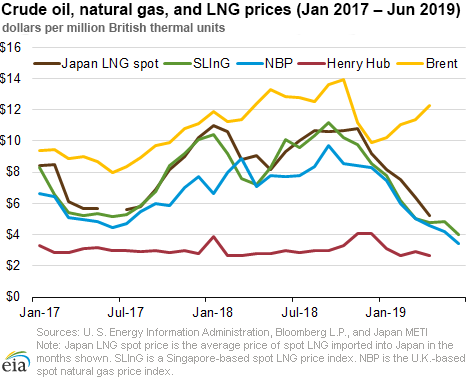
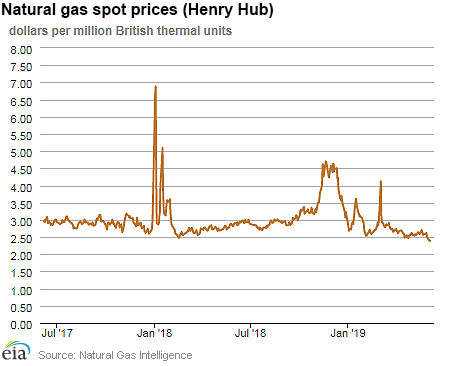
| Spot Prices ($/MMBtu) | Thu, 30-May |
Fri, 31-May |
Mon, 03-Jun |
Tue, 04-Jun |
Wed, 05-Jun |
|---|---|---|---|---|---|
| Henry Hub |
2.53 |
2.47 |
2.42 |
2.39 |
2.39 |
| New York |
2.25 |
2.15 |
2.11 |
2.20 |
2.24 |
| Chicago |
2.35 |
2.22 |
2.20 |
2.18 |
2.21 |
| Cal. Comp. Avg.* |
2.30 |
1.96 |
1.93 |
1.92 |
2.17 |
| Futures ($/MMBtu) | |||||
| July contract | 2.547 |
2.454 |
2.403 |
2.416 |
2.378 |
| August contract |
2.557 |
2.460 |
2.403 |
2.419 |
2.380 |
| *Avg. of NGI's reported prices for: Malin, PG&E Citygate, and Southern California Border Avg. | |||||
| Sources: Natural Gas Intelligence and CME Group as compiled by Bloomberg, L.P. | |||||
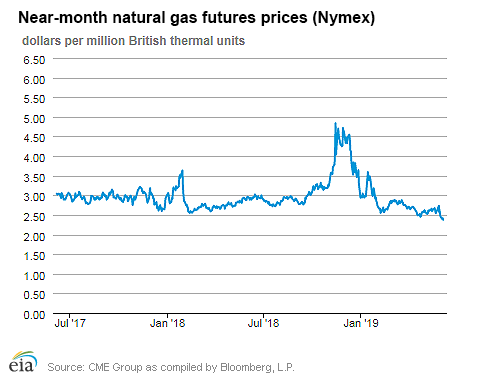
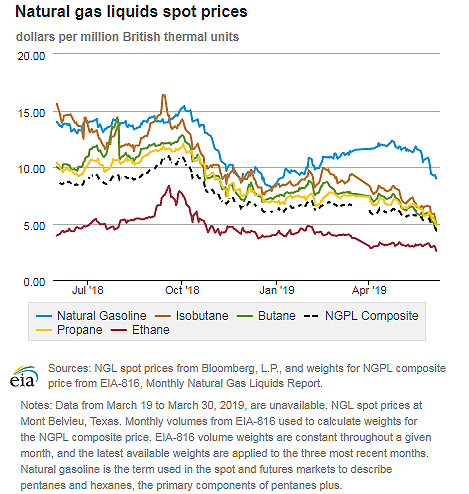
| U.S. natural gas supply - Gas Week: (5/30/19 - 6/5/19) | |||
|---|---|---|---|
Average daily values (Bcf/d): |
|||
this week |
last week |
last year |
|
| Marketed production | 99.7 |
100.4 |
91.5 |
| Dry production | 88.8 |
89.4 |
81.1 |
| Net Canada imports | 5.3 |
4.9 |
6.1 |
| LNG pipeline deliveries | 0.1 |
0.1 |
0.1 |
| Total supply | 94.2 |
94.4 |
87.3 |
|
Source: OPIS PointLogic Energy, an IHS Company | |||
| U.S. natural gas consumption - Gas Week: (5/30/19 - 6/5/19) | |||
|---|---|---|---|
Average daily values (Bcf/d): |
|||
this week |
last week |
last year |
|
| U.S. consumption | 64.9 |
62.5 |
61.6 |
| Power | 33.1 |
29.9 |
30.1 |
| Industrial | 21.6 |
21.1 |
21.2 |
| Residential/commercial | 10.2 |
11.4 |
10.4 |
| Mexico exports | 4.9 |
4.8 |
4.5 |
| Pipeline fuel use/losses | 6.1 |
6.1 |
5.6 |
| LNG pipeline receipts | 5.3 |
5.8 |
2.7 |
| Total demand | 81.1 |
79.2 |
74.3 |
|
Source: OPIS PointLogic Energy, an IHS Company | |||
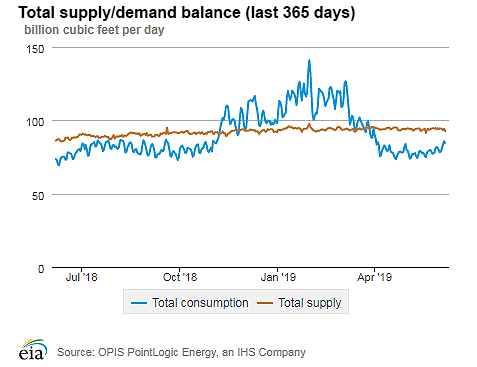
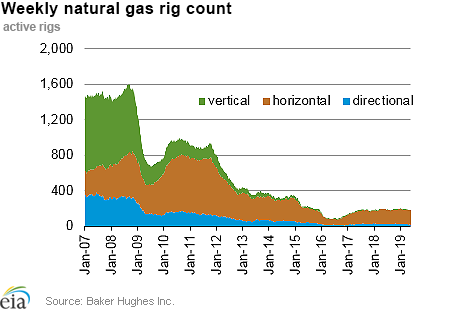
| Rigs | |||
|---|---|---|---|
Tue, May 28, 2019 |
Change from |
||
last week |
last year |
||
| Oil rigs | 800 |
0.4% |
-7.1% |
| Natural gas rigs | 184 |
-1.1% |
-6.6% |
| Note: Excludes any miscellaneous rigs | |||
| Rig numbers by type | |||
|---|---|---|---|
Tue, May 28, 2019 |
Change from |
||
last week |
last year |
||
| Vertical | 52 |
2.0% |
-21.2% |
| Horizontal | 862 |
-0.1% |
-7.2% |
| Directional | 70 |
1.4% |
7.7% |
| Source: Baker Hughes Inc. | |||
| Working gas in underground storage | ||||
|---|---|---|---|---|
Stocks billion cubic feet (Bcf) |
||||
| Region | 2019-05-31 |
2019-05-24 |
change |
|
| East | 414 |
383 |
31 |
|
| Midwest | 436 |
399 |
37 |
|
| Mountain | 101 |
93 |
8 |
|
| Pacific | 213 |
198 |
15 |
|
| South Central | 821 |
793 |
28 |
|
| Total | 1,986 |
1,867 |
119 |
|
|
Source: Form EIA-912, Weekly Underground Natural Gas Storage Report | ||||
| Working gas in underground storage | |||||
|---|---|---|---|---|---|
Historical comparisons |
|||||
Year ago (5/31/18) |
5-year average (2014-2018) |
||||
| Region | Stocks (Bcf) |
% change |
Stocks (Bcf) |
% change |
|
| East | 348 |
19.0 |
427 |
-3.0 |
|
| Midwest | 337 |
29.4 |
473 |
-7.8 |
|
| Mountain | 120 |
-15.8 |
142 |
-28.9 |
|
| Pacific | 230 |
-7.4 |
263 |
-19.0 |
|
| South Central | 769 |
6.8 |
920 |
-10.8 |
|
| Total | 1,804 |
10.1 |
2,226 |
-10.8 |
|
| Source: Form EIA-912, Weekly Underground Natural Gas Storage Report | |||||
| Temperature – heating & cooling degree days (week ending May 30) | ||||||||
|---|---|---|---|---|---|---|---|---|
HDD deviation from: |
CDD deviation from: |
|||||||
| Region | HDD Current |
normal |
last year |
CDD Current |
normal |
last year |
||
| New England | 40 |
2 |
21 |
5 |
2 |
-11 |
||
| Middle Atlantic | 13 |
-15 |
11 |
18 |
8 |
-17 |
||
| E N Central | 14 |
-20 |
13 |
25 |
7 |
-45 |
||
| W N Central | 25 |
-4 |
25 |
26 |
2 |
-55 |
||
| South Atlantic | 0 |
-10 |
0 |
99 |
46 |
24 |
||
| E S Central | 0 |
-9 |
0 |
92 |
48 |
14 |
||
| W S Central | 0 |
-1 |
0 |
99 |
26 |
-14 |
||
| Mountain | 60 |
18 |
48 |
10 |
-21 |
-27 |
||
| Pacific | 46 |
18 |
19 |
1 |
-11 |
-4 |
||
| United States | 21 |
-5 |
14 |
45 |
14 |
-13 |
||
|
Note: HDD = heating degree day; CDD = cooling degree day Source: National Oceanic and Atmospheric Administration | ||||||||
Average temperature (°F)
7-day mean ending May 30, 2019
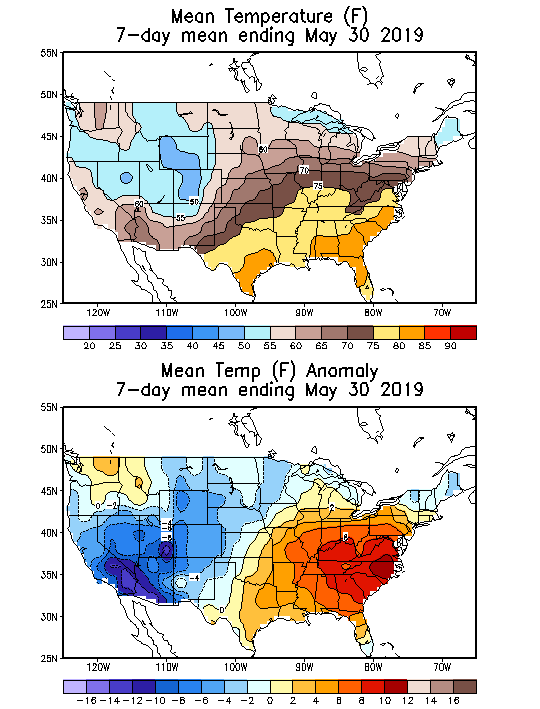
Source: National Oceanic and Atmospheric Administration
Deviation between average and normal (°F)
7-day mean ending May 30, 2019

Source: National Oceanic and Atmospheric Administration

